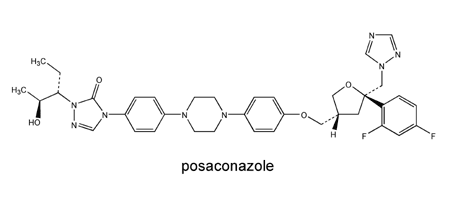Posaconazole (Noxafil)

Mechanism(s) of Action
As with all azole antifungal agents, posaconazole works principally by inhibition of cytochrome P450 14a-demethylase (P45014DM). This enzyme is in the sterol biosynthesis pathway that leads from lanosterol to ergosterol. Compared to Itraconazole, posaconazole is a significantly more potent inhibitor of sterol C14 demethylation, particularly in Aspergillus [1597].
Susceptibility Patterns
The in vitro activity of posaconazole has been tested against more than 18,000 clinical strains of yeasts and moulds. The MIC50 and MIC90 values for posaconazole were 0.063 and 1 mg/mL, respectively. The MIC90 value for posaconazole against all yeasts (18,351 MICs) and moulds (4499 MICs) was 1 mg/mL.
Posaconazole shows excellent activity against Candida, including some species (ie, C krusei, C glabrata, C guilliermondii, and C dubliniensis), inherently less susceptible to fluconazole. Against moulds such as Aspergillus that were also tested against itraconazole, voriconazole, and amphotericin B, lower MIC90 values indicated that posaconazole was either more potent than or equivalent to the comparator drugs. As with voriconazole and amphotericin B, posacoazole demonstrates variable activity against Fusarium spp, as demonstrated by the MIC90 values. However, much of this variability across all antifungals tested can be explained by the high MIC90 values against F solani.
Posaconazole also has activity in vitro against dimorphic fungi, including species of Penicillium, Histoplasma, Blastomyces, Coccidioides, Paracoccidioides, and Sporothrix and agents causing chromoblastomycosis, mycetoma, and phaeohyphomycosis, including Scedosporium apiospermum and species of Exophiala, Alternaria, and Bipolaris. In general, the MIC90 values for posaconazole against these organisms are comparable to or lower than the MIC values for itraconazole or amphotericin B.
Posaconazole is the only currently marketed azole that shows consistent activity against the majority of the Zygomycetes.
Usual Doses
Posaconazole is administered at dosages of 600-800 mg/day in divided doses with food.
Side-Effects
Posaconazole is relatively well tolerated. In clinical trials the most common adverse effects have been nausea and headache. Rash, dry skin, nausea, taste disturbance, abdominal pain, dizziness and flushing can occur. Posaconazole can cause abnormalities in liver function.
Routes
Posaconazole is only available as an oral suspension. An IV formulation is in development.
Clinical studies
Two randomized multicenter trials have accessed the efficacy of posaconazole (200 mg PO tid) in preventing invasive fungal infections compared to standard azole therapy (fluconazole or itraconazole) in high-risk patients with neutropenia or graft versus host disease. A prospective non-blinded study in high-risk neutropenic patients with neutropenia due to either AML or MDS randomized 602 patients to receive posaconazole (n=298) or either fluconazole or itraconazole (n=304) until neutrophil recovery or occurrence of an invasive fungal infection (IFI) for up to 84 days. (Cornely et al. 46th ICAAC). Proven or probable IFI were diagnosed in 7 patients (2%) in the posaconazole group versus 25 (8%) in the comparator group. The majority of breakthrough infections in the fluconazole/itraconazole arm were due to aspergillosis.
A double-blinded study in allogeneic HSCT patients with graft versus host disease (GVHD) compared fluconazole (n=299) or posaconazole (n=301) for up to 112 days or until the occurrence of an IFI. Proven or probable IFI were diagnosed in 16 patients (5%) in the posaconazole group and 27 (9%) in the fluconazole group. [AJ Ullman et al. ICAAC 2006].
An open-label, multicenter, case-controlled clinical trial of posaconazole as salvage therapy in a patients with IFIs has also been completed for a variety of IFI that failed primary therapy (predominantly amphotericin B regimens). Among patients with aspergillosis (n=107), the global response to posaconazole therapy (800 mg/day divided doses) was 42% versus 26% response in contemporary control patients who received other licensed antifungal therapy (P =0.006).
Preliminary data also suggest that posaconazole may be an effective therapy for zygomycosis unresponsive to amphotericin B-based regimens.
